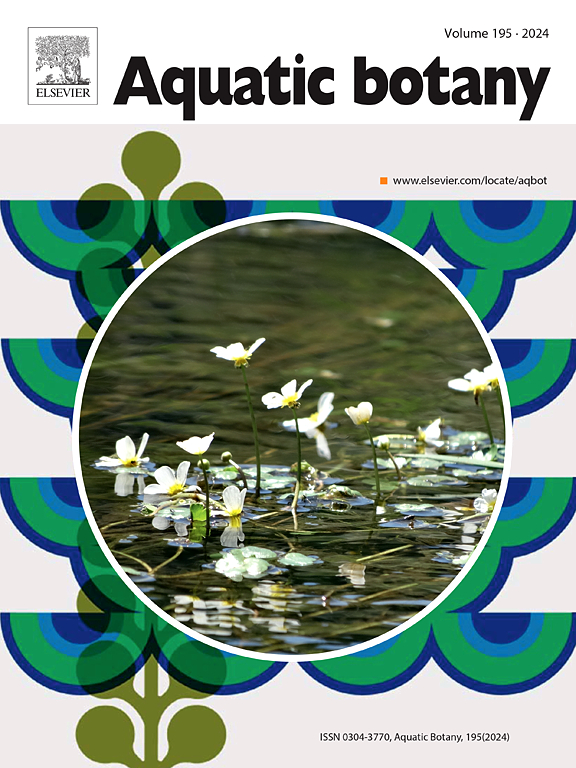Effects of light and temperature on volatile mediated seaweed-bacteria interactions
IF 2.6
4区 生物学
Q2 MARINE & FRESHWATER BIOLOGY
引用次数: 0
Abstract
Land plants strongly contribute to BVOCs (biogenic volatile organic compounds) which serve multiple ecological roles. Aquatic macrophytes such as seaweeds underpin some of the most extensive and productive coastal ecosystems globally. However, seaweed health and fitness can be negatively impacted through excessive bacterial colonisation on their surface. Just like land plants, seaweeds employ a range of chemicals to deter, reduce or “garden” epibacterial colonisation. Like plants, seaweeds are known to be prolific producers of BVOCs in the marine environment. However, unlike plants, the ecological roles of seaweed BVOCs, particularly in mediating seaweed-bacteria interactions, has hardly been explored, especially when compared to the role of non-volatile compounds. Although BVOC production is known to vary with abiotic factors in seaweeds, we do not know yet how such variations may alter ecological interactions of seaweeds with bacteria. Using two ecologically important seaweeds, Fucus serratus and Palmaria palmata, we investigated how different different light and temperature conditions can influence BVOCs mediated interactions of seaweeds with their bacteria We tested F. serratus and P. palmata BVOCs for their effect upon settlement in twelve common marine bacterial strains for the temperature experiment and seven common bacterial strains for the light experiment. When the seaweeds were incubated at higher temperature (21°C), the bacterial strains in contact with BVOCs from both F. serratus and P. palmata had a higher relative settlement compared to seaweeds incubated at ambient temperature (16°C). Overall temperature had a stronger significant effect than species identity. The effect of light on the BVOC mediated seaweed-bacteria interaction was less distinct but had a stronger inter-specific effect.
Synthesis
Our results provide the first evidence from an aquatic environment that BVOC mediated ecological interactions can vary between seaweed species and with light and temperature.
光和温度对挥发性海藻-细菌相互作用的影响
陆地植物对BVOCs(生物源性挥发性有机化合物)的贡献很大,BVOCs具有多种生态作用。海藻等水生大型植物支撑着全球一些最广泛和最具生产力的沿海生态系统。然而,海藻的健康和适应性可能会受到其表面过多细菌定植的负面影响。就像陆地植物一样,海藻使用一系列化学物质来阻止、减少或“花园”表面细菌的定植。与植物一样,众所周知,在海洋环境中,海藻是BVOCs的多产制造者。然而,与植物不同,海藻BVOCs的生态作用,特别是在介导海藻-细菌相互作用方面,几乎没有被探索过,特别是与非挥发性化合物的作用相比。虽然已知BVOC的产生随海藻中的非生物因素而变化,但我们还不知道这种变化如何改变海藻与细菌的生态相互作用。以具有重要生态意义的黑角藻(Fucus serratus)和棕榈藻(Palmaria palmata)为研究对象,研究了不同光照和温度条件对BVOCs介导的海藻与细菌相互作用的影响。在12种常见的海洋细菌中进行温度实验,在7种常见的海洋细菌中进行光照实验,测试了黑角藻(F. serratus)和棕榈藻(P. palmata) BVOCs对沉降的影响。在较高温度(21℃)下培养的海藻中,与serratus和P. palmata BVOCs接触的菌株的相对沉降量均高于常温(16℃)下培养的海藻。总体温度的显著影响强于物种特征。光对BVOC介导的海藻-细菌相互作用的影响不明显,但具有较强的种间效应。我们的研究结果提供了来自水生环境的第一个证据,表明BVOC介导的生态相互作用可以在海藻种类之间以及光照和温度之间发生变化。
本文章由计算机程序翻译,如有差异,请以英文原文为准。
求助全文
约1分钟内获得全文
求助全文
来源期刊

Aquatic Botany
生物-海洋与淡水生物学
CiteScore
3.80
自引率
5.60%
发文量
70
审稿时长
6 months
期刊介绍:
Aquatic Botany offers a platform for papers relevant to a broad international readership on fundamental and applied aspects of marine and freshwater macroscopic plants in a context of ecology or environmental biology. This includes molecular, biochemical and physiological aspects of macroscopic aquatic plants as well as the classification, structure, function, dynamics and ecological interactions in plant-dominated aquatic communities and ecosystems. It is an outlet for papers dealing with research on the consequences of disturbance and stressors (e.g. environmental fluctuations and climate change, pollution, grazing and pathogens), use and management of aquatic plants (plant production and decomposition, commercial harvest, plant control) and the conservation of aquatic plant communities (breeding, transplantation and restoration). Specialized publications on certain rare taxa or papers on aquatic macroscopic plants from under-represented regions in the world can also find their place, subject to editor evaluation. Studies on fungi or microalgae will remain outside the scope of Aquatic Botany.
 求助内容:
求助内容: 应助结果提醒方式:
应助结果提醒方式:


